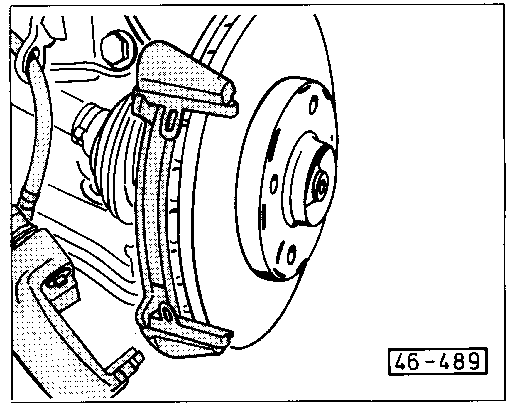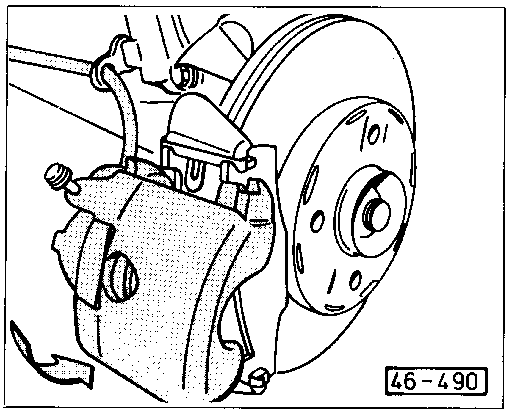Removing and Installing Brake Pads (all except 1989 and later 16V models)
Although the calipers must be removed to change the brake pads, this can be done without disconnecting the flexible brake hose. Keeping the hydraulic system sealed eliminates the need to bleed the brakes afterward.
Brake pads and the surfaces of the rotors wear slightly differently. Always replace brake pads in complete sets. If old pads are to be reinstalled, such as after inspecting them, always make sure they are refitted in their original locations.
To remove
| 1. | Raise the front of the car and support it securely on jack stands. Remove the front wheels. |
| 2. | Using a hex wrench, remove the two brake caliper mounting bolts, the spacers, and the sleeves. Push the caliper up slightly and swing it out from the bottom, as shown in Fig. 5-3, to remove it from the pad carrier. Suspend the caliper from the car body with a stiff wire to avoid stretching the brake hose. |
NOTE-
If the piston creeps out of the caliper due to residual pressure in the brake lines, place a rubber band around the piston and caliper to hold the piston.
|
| Fig. 5-3. | Brake caliper being removed from pad carrier. Slide caliper out from bottom first (arrow). |

|
| 3. | Lift out the pads and the anti-rattle springs from the pad carrier. |
CAUTION-
If the pads are to be reused, mark the pads so that they can be reinstalled in their original position.
|
To install:
| 1. | Install the anti-rattle springs on the pad carrier and hold them in place with the inner brake pad, as shown in Fig. 5-4. Then, install the outer pad. |
| Fig. 5-4. | Anti-rattle springs and inner brake pad installed in brake pad carrier. |

|
| 2. | When installing new brake pads, slowly push the piston back into the caliper to provide clearance for the thicker new brake pads. |
NOTE-
Pushing in the caliper pistons to gain clearance for the thicker new brake pads will cause brake fluid to overflow the master cylinder fluid reservoir. To prevent this, use a clean syringe to first remove some fluid from the reservoir.
|
| 3. | Engage the caliper with the upper part of the pad carrier, and pivot the bottom of the caliper into position over the pads, as shown in Fig. 5-5. Be careful not to damage the caliper piston dust seal. |
| Fig. 5-5. | Brake caliper being pivoted into position on pad carrier over brake pads. Engage top part first and follow with bottom (arrow). |

|
| 4. | Install the spacers, the sleeves, and the caliper mounting bolts. The longer parts should be installed in the upper mount. Torque the socket-head mounting bolts to 25 Nm (18 ft. lb.). |
CAUTION-
Make sure that the caliper mounting bolts, the sleeves, the bushings, and the spacers are clean and free of corrosion.
|
| 5. | Mount the wheel and loosely install the lug bolts. Lower the car then torque the lug bolts to 110 Nm (81 ft. lb.). |
| 6. | Depress the brake pedal several times to adjust the caliper and brake pads to the rotor. |
| 7. | Check the level of brake fluid in the reservoir. If necessary, add new brake fluid to fill the reservoir to the MAX mark. |
WARNING-
New brake pads require some break-in. Allow for slightly longer stopping distances for the first 100 to 150 miles of city driving, and avoid hard stops.
|
|


